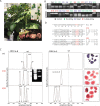High efficacy full allelic CRISPR/Cas9 gene editing in tetraploid potato
- PMID: 31776399
- PMCID: PMC6881354
- DOI: 10.1038/s41598-019-54126-w
High efficacy full allelic CRISPR/Cas9 gene editing in tetraploid potato
Abstract
CRISPR/Cas9 editing efficacies in tetraploid potato were highly improved through the use of endogenous potato U6 promoters. Highly increased editing efficiencies in the Granular Bound Starch Synthase gene at the protoplast level were obtained by replacement of the Arabidopsis U6 promotor, driving expression of the CRISPR component, with endogenous potato U6 promotors. This translated at the ex-plant level into 35% full allelic gene editing. Indel Detection Amplicon Analysis was established as an efficient tool for fast assessment of gene editing in complex genomes, such as potato. Together, this warrants significant reduction of laborious cell culturing, ex-plant regeneration and screening procedures of plants with high complexity genomes.
Conflict of interest statement
The authors declare no competing interests.
Figures


References
-
- Potato Genome Sequencing, C. et al. Genome sequence and analysis of the tuber crop potato. Nature475, 189-195 (2011). - PubMed
Publication types
MeSH terms
LinkOut - more resources
Full Text Sources
Other Literature Sources

